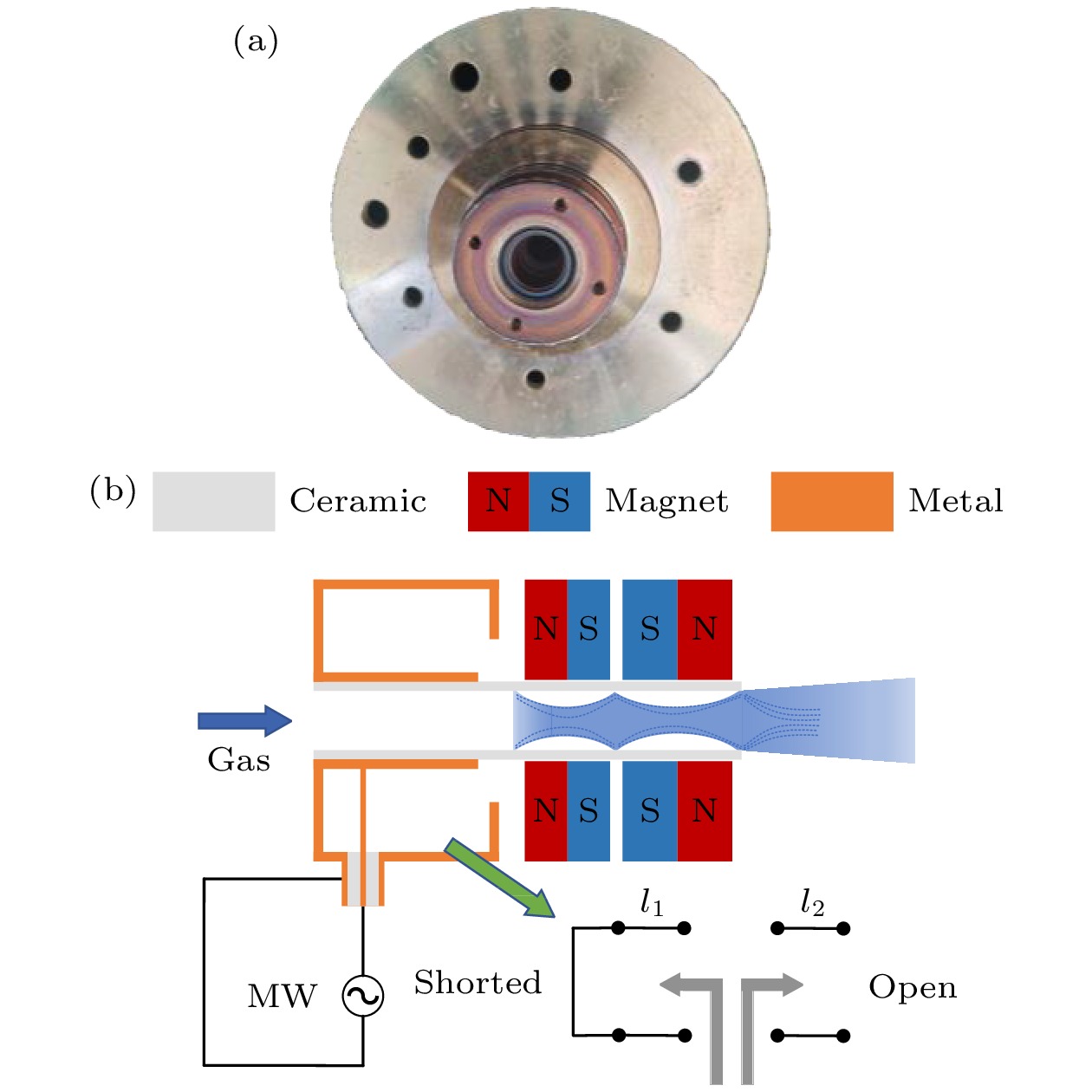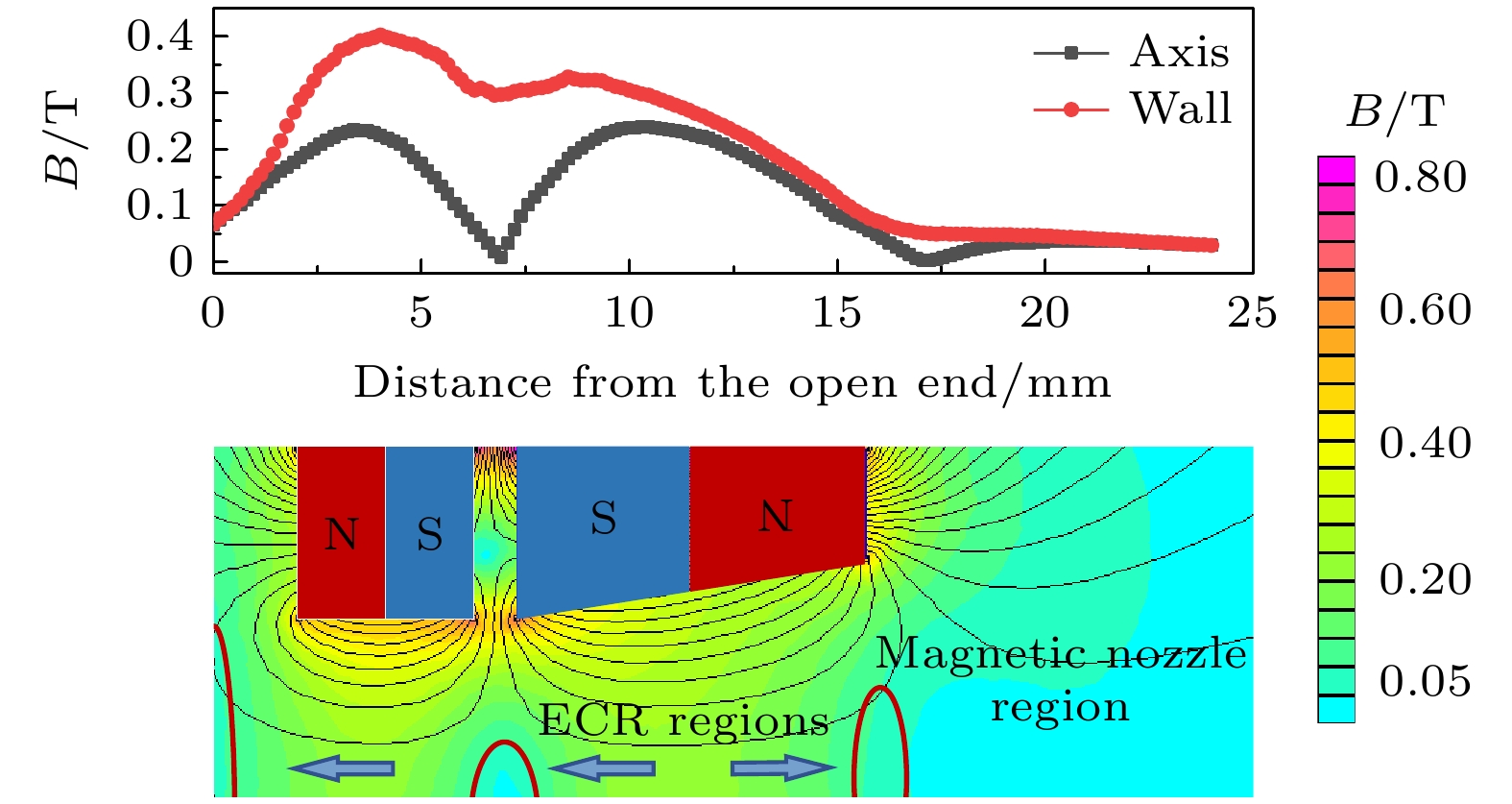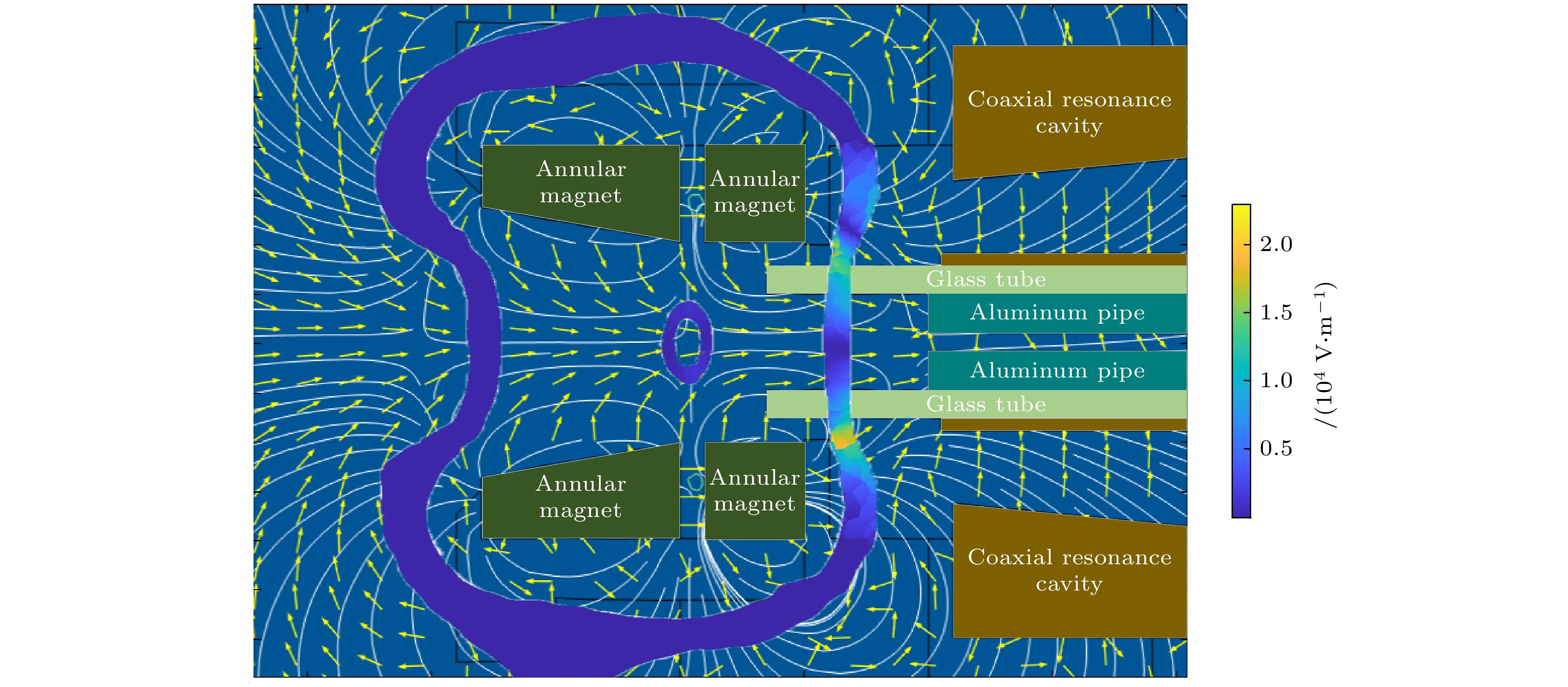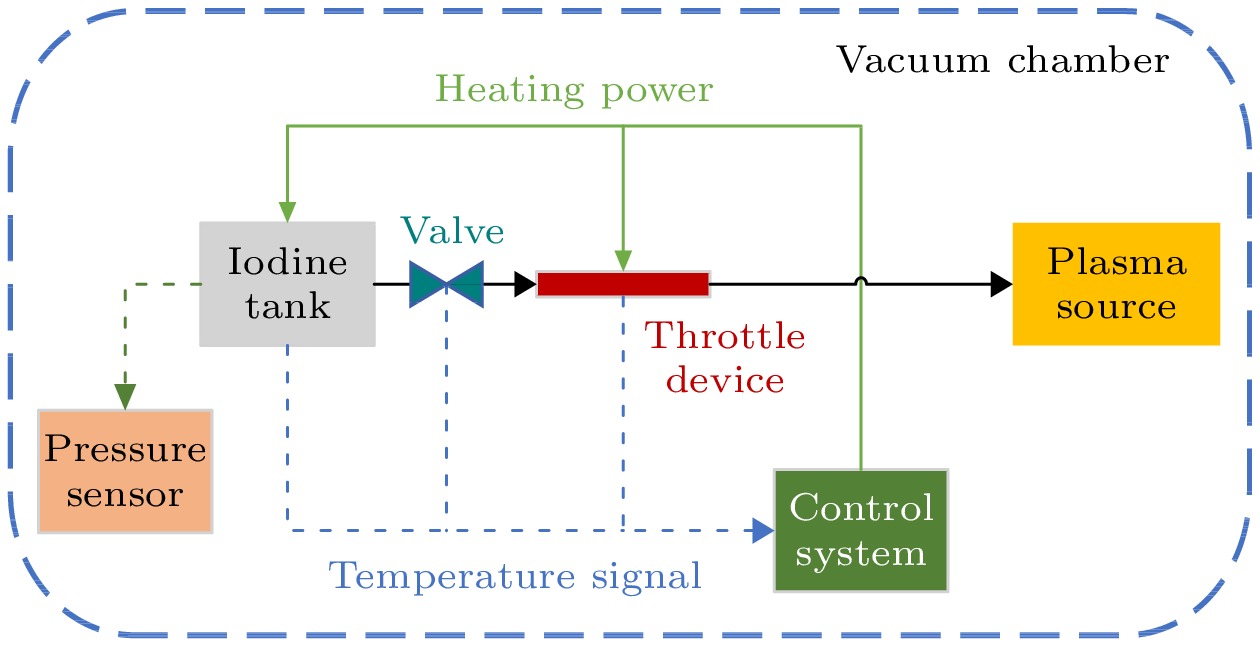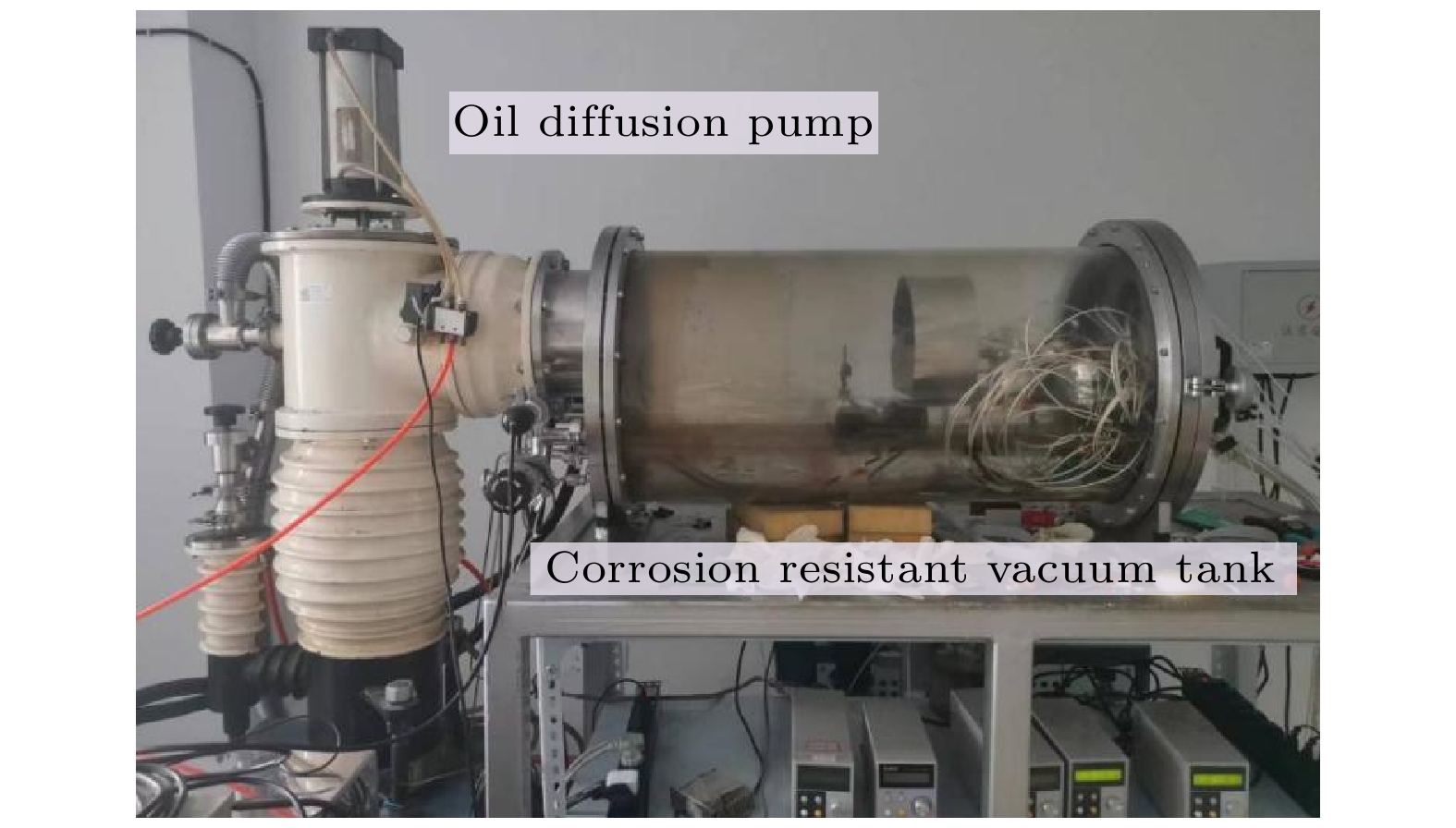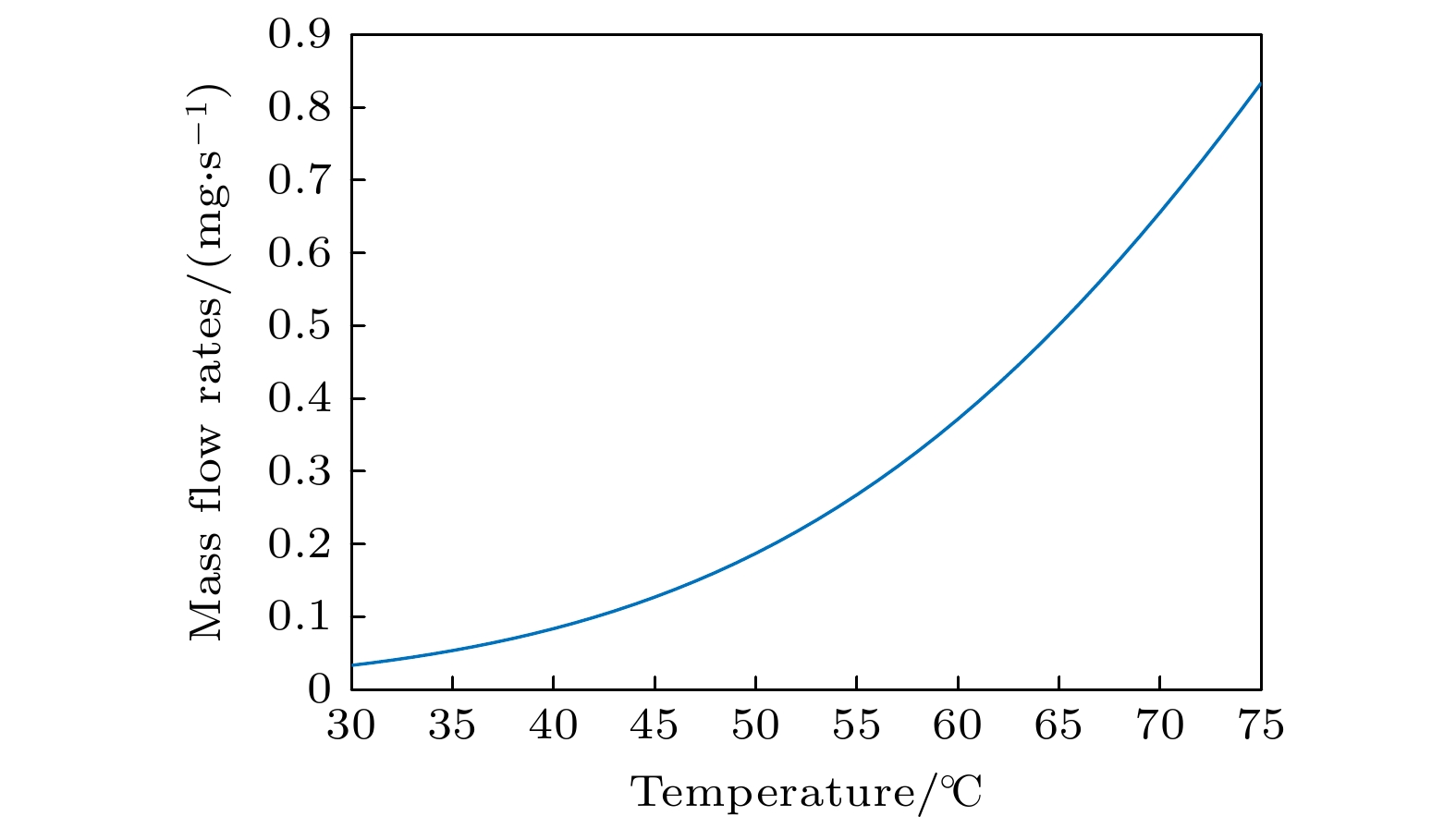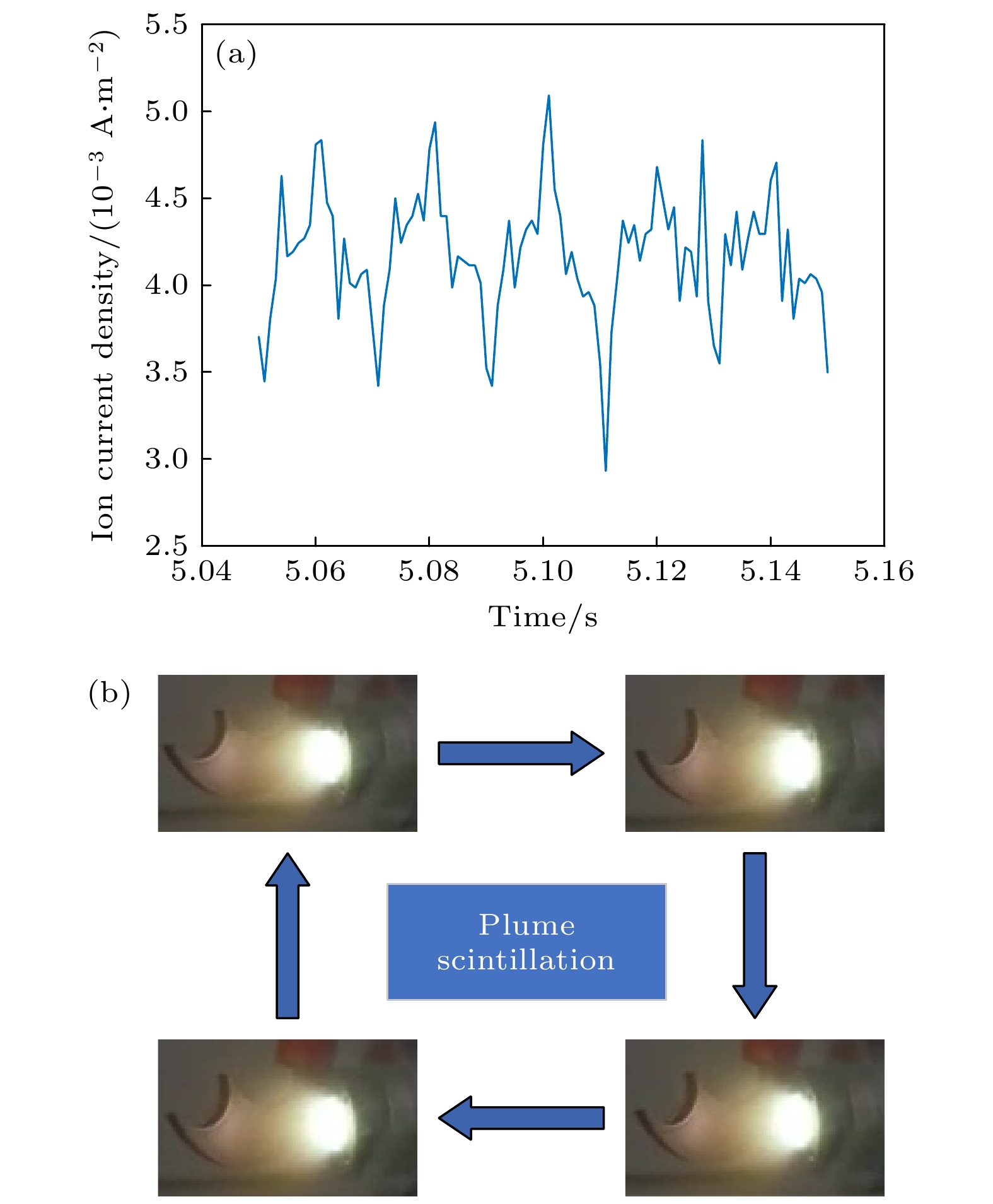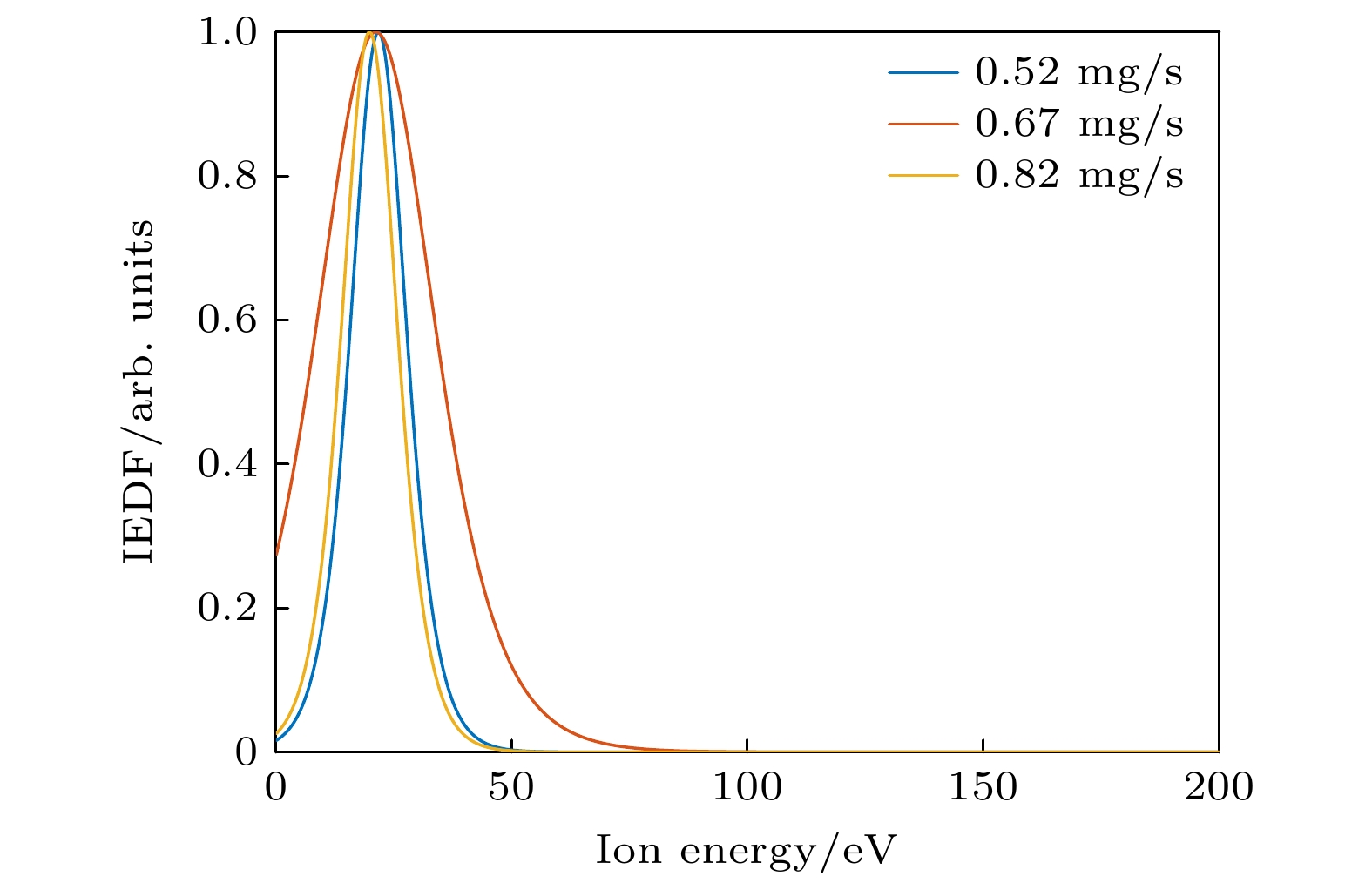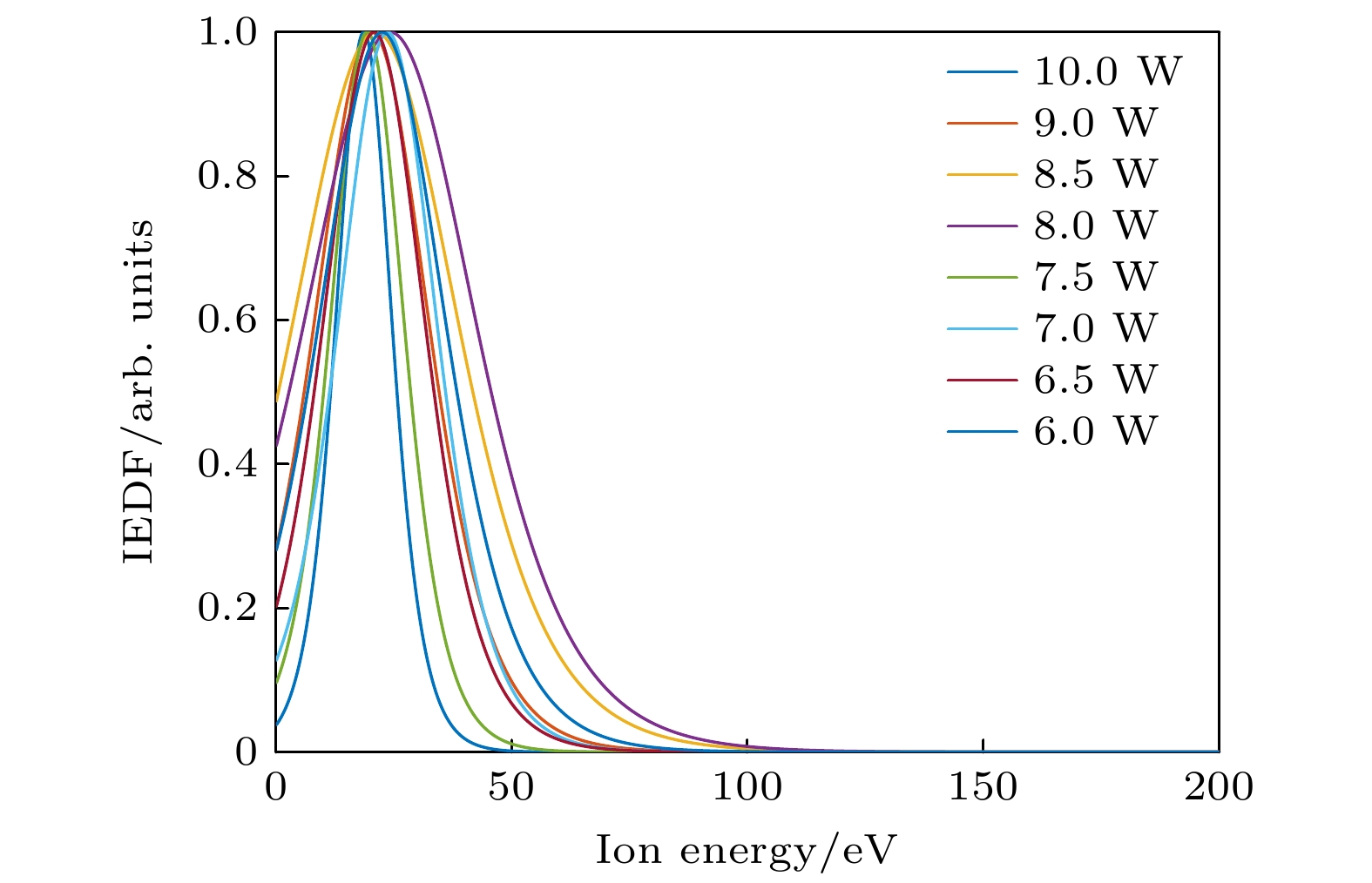-
电子回旋共振(electron cyclotron resonance, ECR)源具有无需内电极、低气压电离、等离子体密度较高和结构紧凑等优点, 适用于小功率电推进. 因此, 研究小功率碘工质ECR等离子体源具有重要意义. 本文首先设计了一套耐腐蚀且可以均衡稳定输出碘蒸汽的储供系统; 然后完成了耐碘腐蚀ECR推力器设计, 利用耐腐蚀的同轴谐振腔结构将微波馈送到推力器, 并将通道磁场变为会切型磁场以产生更多ECR层; 最终联合点火实验成功, 成为国际上首个可以用于电推进的ECR电离碘工质等离子体源. 分析实验和静磁场、微波电场分布发现, 小功率、低流量下的不稳定等离子体羽流闪烁由寻常波电子等离子体共振加热和非寻常波ECR加热模式之间的转化引起. 高流量下电离率下降是由电子损失、壁面损失和碘工质电负性导致. 并依据此原理提出了改进方案. 放电后等离子体源没有明显损伤, 说明具备长寿命潜力. 此项工作初步证实了小功率碘工质ECR电推进方案可行.
-
关键词:
- 电推进 /
- 碘工质 /
- 贮供系统 /
- 电子回旋共振等离子体源
With the rapid development of commercial space in recent years, the low-power and low-cost propulsion systems are needed more and more urgently. Compared with conventional chemical propulsion, electric propulsion has a higher specific impulse. Compared with the conventional xenon propellant, iodine propellant that does not require high pressure storage, is cheap and close to the relative atomic mass and ionization energy of xenon. Electron cyclotron resonance source has the advantages of no internal electrode, low pressure ionization, high plasma density and compact structure, which is suitable for low power electric propulsion. Therefore, the study of low power iodine propellant electron cyclotron resonance plasma source is of great significance. In this study, a set of corrosion-resistant feed system with balanced and stable output of iodine vapor is designed. Then the iodine-corrosion-resistant electron cyclotron resonance thruster is designed completely. A corrosion-resistant coaxial cavity structure is used to feed the microwave to the thruster, and the channel magnetic field is changed into a cusped field to generate more electron cyclotron resonance (ECR) layers. Finally, the combined ignition experiment is successfully conducted, showing the first plasma source using electron cyclotron resonance to ionize iodine propellant that can be used for electric propulsion in the world. The analyses of experiments, static magnetic field, microwave electric field distribution show that the unstable plasma plume scintillation at low power and low flow is caused by the conversion between ordinary wave electron plasmon resonance heating mode and extraordinary wave electron cyclotron resonance heating mode. The decrease of ionization rate at a high flow rate is caused by electron loss, wall loss and electronegativity of iodine propellant. Based on this principle, an improvement scheme is proposed. The plasma source has no obvious damage after discharge, which indicates that it has the potential of long life. This work preliminarily proves that the low power electron cyclotron resonance electric propulsion scheme of low power iodine propellant is feasible.-
Keywords:
- electric propulsion /
- iodine propellant /
- feed system /
- electron cyclotron resonance plasma source
[1] Heidt H, Puig-Suari J, Moore A S, Nakasuka S, Twiggs R J 2000 Proceedings of the 14th Annual/USU Conference on Small Satellites Logan, August 21–24, 2000 SSC00-V-5
[2] 许亮亮, 蔡明辉, 杨涛, 韩建伟 2020 物理学报 69 165203
 Google Scholar
Google Scholar
Xu L L, Cai M H, Yang T, Han J W 2020 Acta Phys. Sin. 69 165203
 Google Scholar
Google Scholar
[3] Poghosyan A, Golkar A 2017 Prog. Aero. Sci. 88 59
 Google Scholar
Google Scholar
[4] Tsay M, Model J, Barcroft C, Frongillo J, Zwahlen J, Feng C 2017 Proceedings of the 35th International Electric Propulsion Conference Atlanta, USA, October 8–12, 2017 IEPC-2017-264
[5] Hillier A, Branam R, Huffman R, Szabo J, Paintal S 2011 Proceedings of the 49th AIAA Aerospace Sciences Meeting including the New Horizons Forum and Aerospace Exposition Orlando, Florida, January 4–7, 2011 AIAA-2011-524
[6] Dankanich J W, Calvert D, Kamhawi H, Hickman T, Szabo J, Byrne L 2015 Proceedings of the 34th International Electric Propulsion Conference Kobe-Hyogo, July 4–10, 2015 IEPC-2015-303
[7] Polzin K A, Seixal J F, Mauro S L, Burt A O, Martinez A, Martin A K 2017 Proceedings of the 35th International Electric Propulsion Conference Atlanta, Georgia, October 8–12, 2017 IEPC-2017-11
[8] Szabo J, Robin M, Paintal S, Pote B, Hruby V, Freeman C 2013 Proceedings of the 33th International Electric Propulsion Conference Washington, D. C., October 6–10, 2013 IEPC-2013-311
[9] Tsay M, Frongillo J, Hohman K 2015 Proceedings of the 34th International Electric Propulsion Conference Hyogo-Kobe, July 4–10, 2015 IEPC-2015-273
[10] Rafalskyi D, Martínez J M, Habl L, Rossi E Z, Proynov P, Boré A, Baret T, Poyet A, Lafleur T, Dudin S, Aanesland A 2021 Nature 599 411
 Google Scholar
Google Scholar
[11] Manente M, Trezzolani F, Mantellato R, Scalzi D, Schiavon A, Souhair N, Duzzi M, Barato F, Cappellini L, Barbato A, Paulon D, Selmo A, Bellomo N, Gloder A, Toson E, Minute M, Magarotto M, Pavarin D 2019 Proceedings of the 36th International Electric Propulsion Conference Vienna, September 15–20, 2019 IEPC-2019-417
[12] Manente M, Trezzolani F, Mantellato R, Scalzi D, Schiavon A, Cappellini L, Barato F, Bellomo N, Gloder A, Toson E, Minute M, Vallisari D, Magarotto M, Pavarin D 2019 Proceedings of the 36th International Electric Propulsion Conference Vienna, September 15–20, 2019 IEPC-2019-419
[13] Bellomo N, Magarotto M, Manente M, Trezzolani F, Mantellato R, Cappellini L, Paulon D, Selmo A, Scalzi D, Minute M, Duzzi M, Barbato A, Schiavon A, Fede S D, Souhair N, Carlo P D, Barato F, Milza F, Toson E, Pavarin D 2022 CEAS Space J. 14 79
 Google Scholar
Google Scholar
[14] Szabo1 J, Pote B, Paintal S, Robin M, Hillier A, Branam R D, Huffman R E 2012 J. Propul. Power 28 848
 Google Scholar
Google Scholar
[15] Dankanich J W, Szabo J, Pote B, Oleson S, Kamhawi H 2014 Proceedings of the 50th AIAA/ASME/SAE/ASEE Joint Propulsion Conference Cleveland, July 28–30, 2014 AIAA-2014-3905
[16] Tsay M, Frongillo J, Hohman K, Malphrus B K 2015 Proceedings of the 29th AIAA/USU Conference on Small Satellites Logan, August 9, 2015 SSC15-XI-1
[17] Yang J H, Jia S X, Zhang Z H, Zhang X H, Jin T, Li L, Cai Y, Cai J 2020 Plasma Sci. Technol. 22 094006
 Google Scholar
Google Scholar
[18] 申英杰 2010 硕士学位论文(哈尔滨: 哈尔滨工业大学)
Shen Y J 2010 M. S. Thesis (Harbin: Harbin Institute of Technology
[19] Shuaibov A K, Grabovaya I A, Gomoki Z T, Kalyuzhnaya A G, Shchedrin A I 2009 Tech. Phys. 54 1819
 Google Scholar
Google Scholar
[20] Matsutani A, Ohtsuki H, Koyama F 2005 Jpn. J. Appl. Phys. 44 L576
 Google Scholar
Google Scholar
[21] Fehsenfeld F C, Evanson K M, Broida H P 1965 Rev. Sci. Instrum. 36 294
 Google Scholar
Google Scholar
[22] Hawley M C, Asmussen J, Filpus J W, Whitehair S, Hoekstra C, Morin T J, Chapman R 1989 J. Propul. Power 5 703
 Google Scholar
Google Scholar
[23] Agnihotri A N, Kelkar A H, Kasthurirangan S, Thulasiram K V, Desai C A, Fernandez W A, Tribedi L C 2011 Phys. Scr. T144 014038
 Google Scholar
Google Scholar
[24] Biri S, Rácz R, Pálinkás J 2012 Rev. Sci. Instrum. 83 02A341
 Google Scholar
Google Scholar
[25] Hargus W A, Lubkeman J S, Remy K E, Gonzales A E 2012 Proceedings of the 48th AIAA/ASME/SAE/ASEE Joint Propulsion Conference & Exhibit Atlanta, Georgia, July 30–August 1, 2012 AIAA-2012-4316
[26] Leins M, Kopecki J, Gaiser S, Schulz A, Walker M, Schumacher U, Stroth U, Hirth T 2014 Contrib. Plasma Phys. 54 14
 Google Scholar
Google Scholar
[27] Koizumi H, Kuninaka H 2011 Proceedings of the 32nd International Electric Propulsion Conference Wiesbaden, September 11–15, 2011 IEPC-2011-297
[28] Désangles V, Packan D, Jarrige J, Peterschmitt S, Dietz P, Scharmann S, Holste K, Klar P 2022 Proceedings of the 37th International Electric Propulsion Conference Cambridge, June 19–23, 2022 IEPC-2022-513
[29] Fu S H, Ding Z F 2021 Phys. Plasmas 28 033510
 Google Scholar
Google Scholar
[30] Zeng M, Liu H, Chen Z Q, Huang H Y, Yu D R 2021 Vacuum 192 110486
 Google Scholar
Google Scholar
-
-
[1] Heidt H, Puig-Suari J, Moore A S, Nakasuka S, Twiggs R J 2000 Proceedings of the 14th Annual/USU Conference on Small Satellites Logan, August 21–24, 2000 SSC00-V-5
[2] 许亮亮, 蔡明辉, 杨涛, 韩建伟 2020 物理学报 69 165203
 Google Scholar
Google Scholar
Xu L L, Cai M H, Yang T, Han J W 2020 Acta Phys. Sin. 69 165203
 Google Scholar
Google Scholar
[3] Poghosyan A, Golkar A 2017 Prog. Aero. Sci. 88 59
 Google Scholar
Google Scholar
[4] Tsay M, Model J, Barcroft C, Frongillo J, Zwahlen J, Feng C 2017 Proceedings of the 35th International Electric Propulsion Conference Atlanta, USA, October 8–12, 2017 IEPC-2017-264
[5] Hillier A, Branam R, Huffman R, Szabo J, Paintal S 2011 Proceedings of the 49th AIAA Aerospace Sciences Meeting including the New Horizons Forum and Aerospace Exposition Orlando, Florida, January 4–7, 2011 AIAA-2011-524
[6] Dankanich J W, Calvert D, Kamhawi H, Hickman T, Szabo J, Byrne L 2015 Proceedings of the 34th International Electric Propulsion Conference Kobe-Hyogo, July 4–10, 2015 IEPC-2015-303
[7] Polzin K A, Seixal J F, Mauro S L, Burt A O, Martinez A, Martin A K 2017 Proceedings of the 35th International Electric Propulsion Conference Atlanta, Georgia, October 8–12, 2017 IEPC-2017-11
[8] Szabo J, Robin M, Paintal S, Pote B, Hruby V, Freeman C 2013 Proceedings of the 33th International Electric Propulsion Conference Washington, D. C., October 6–10, 2013 IEPC-2013-311
[9] Tsay M, Frongillo J, Hohman K 2015 Proceedings of the 34th International Electric Propulsion Conference Hyogo-Kobe, July 4–10, 2015 IEPC-2015-273
[10] Rafalskyi D, Martínez J M, Habl L, Rossi E Z, Proynov P, Boré A, Baret T, Poyet A, Lafleur T, Dudin S, Aanesland A 2021 Nature 599 411
 Google Scholar
Google Scholar
[11] Manente M, Trezzolani F, Mantellato R, Scalzi D, Schiavon A, Souhair N, Duzzi M, Barato F, Cappellini L, Barbato A, Paulon D, Selmo A, Bellomo N, Gloder A, Toson E, Minute M, Magarotto M, Pavarin D 2019 Proceedings of the 36th International Electric Propulsion Conference Vienna, September 15–20, 2019 IEPC-2019-417
[12] Manente M, Trezzolani F, Mantellato R, Scalzi D, Schiavon A, Cappellini L, Barato F, Bellomo N, Gloder A, Toson E, Minute M, Vallisari D, Magarotto M, Pavarin D 2019 Proceedings of the 36th International Electric Propulsion Conference Vienna, September 15–20, 2019 IEPC-2019-419
[13] Bellomo N, Magarotto M, Manente M, Trezzolani F, Mantellato R, Cappellini L, Paulon D, Selmo A, Scalzi D, Minute M, Duzzi M, Barbato A, Schiavon A, Fede S D, Souhair N, Carlo P D, Barato F, Milza F, Toson E, Pavarin D 2022 CEAS Space J. 14 79
 Google Scholar
Google Scholar
[14] Szabo1 J, Pote B, Paintal S, Robin M, Hillier A, Branam R D, Huffman R E 2012 J. Propul. Power 28 848
 Google Scholar
Google Scholar
[15] Dankanich J W, Szabo J, Pote B, Oleson S, Kamhawi H 2014 Proceedings of the 50th AIAA/ASME/SAE/ASEE Joint Propulsion Conference Cleveland, July 28–30, 2014 AIAA-2014-3905
[16] Tsay M, Frongillo J, Hohman K, Malphrus B K 2015 Proceedings of the 29th AIAA/USU Conference on Small Satellites Logan, August 9, 2015 SSC15-XI-1
[17] Yang J H, Jia S X, Zhang Z H, Zhang X H, Jin T, Li L, Cai Y, Cai J 2020 Plasma Sci. Technol. 22 094006
 Google Scholar
Google Scholar
[18] 申英杰 2010 硕士学位论文(哈尔滨: 哈尔滨工业大学)
Shen Y J 2010 M. S. Thesis (Harbin: Harbin Institute of Technology
[19] Shuaibov A K, Grabovaya I A, Gomoki Z T, Kalyuzhnaya A G, Shchedrin A I 2009 Tech. Phys. 54 1819
 Google Scholar
Google Scholar
[20] Matsutani A, Ohtsuki H, Koyama F 2005 Jpn. J. Appl. Phys. 44 L576
 Google Scholar
Google Scholar
[21] Fehsenfeld F C, Evanson K M, Broida H P 1965 Rev. Sci. Instrum. 36 294
 Google Scholar
Google Scholar
[22] Hawley M C, Asmussen J, Filpus J W, Whitehair S, Hoekstra C, Morin T J, Chapman R 1989 J. Propul. Power 5 703
 Google Scholar
Google Scholar
[23] Agnihotri A N, Kelkar A H, Kasthurirangan S, Thulasiram K V, Desai C A, Fernandez W A, Tribedi L C 2011 Phys. Scr. T144 014038
 Google Scholar
Google Scholar
[24] Biri S, Rácz R, Pálinkás J 2012 Rev. Sci. Instrum. 83 02A341
 Google Scholar
Google Scholar
[25] Hargus W A, Lubkeman J S, Remy K E, Gonzales A E 2012 Proceedings of the 48th AIAA/ASME/SAE/ASEE Joint Propulsion Conference & Exhibit Atlanta, Georgia, July 30–August 1, 2012 AIAA-2012-4316
[26] Leins M, Kopecki J, Gaiser S, Schulz A, Walker M, Schumacher U, Stroth U, Hirth T 2014 Contrib. Plasma Phys. 54 14
 Google Scholar
Google Scholar
[27] Koizumi H, Kuninaka H 2011 Proceedings of the 32nd International Electric Propulsion Conference Wiesbaden, September 11–15, 2011 IEPC-2011-297
[28] Désangles V, Packan D, Jarrige J, Peterschmitt S, Dietz P, Scharmann S, Holste K, Klar P 2022 Proceedings of the 37th International Electric Propulsion Conference Cambridge, June 19–23, 2022 IEPC-2022-513
[29] Fu S H, Ding Z F 2021 Phys. Plasmas 28 033510
 Google Scholar
Google Scholar
[30] Zeng M, Liu H, Chen Z Q, Huang H Y, Yu D R 2021 Vacuum 192 110486
 Google Scholar
Google Scholar
计量
- 文章访问数: 7280
- PDF下载量: 128
- 被引次数: 0













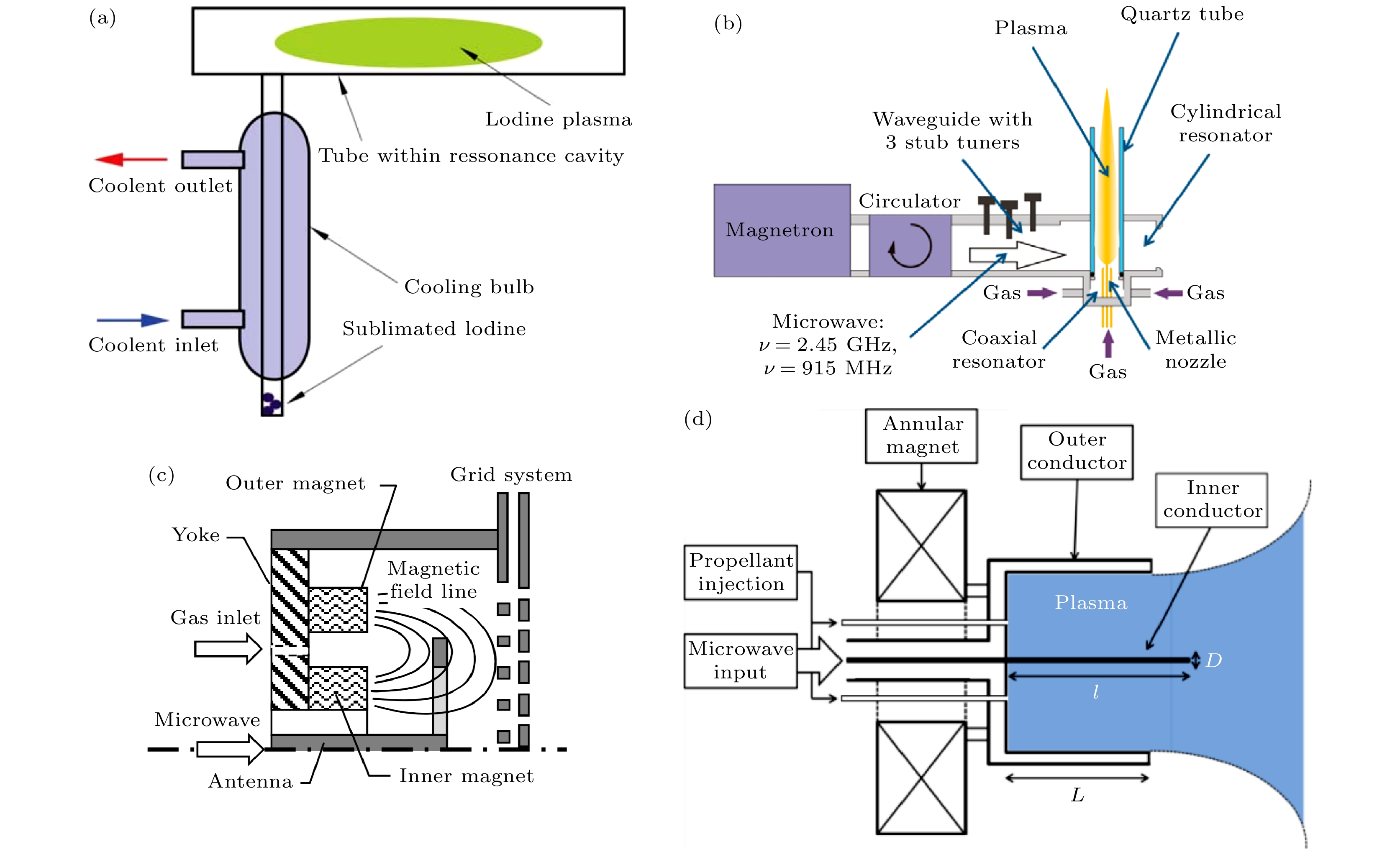
 下载:
下载:
